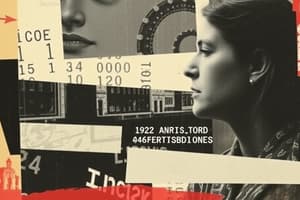Podcast
Questions and Answers
What is the smallest unit of data that can be stored in a computer?
What is the smallest unit of data that can be stored in a computer?
- Bit (correct)
- Nibble
- Word
- Byte
Which representation is used for numbers stored as integers in a computer?
Which representation is used for numbers stored as integers in a computer?
- Floating-point representation
- Fixed-point representation (correct)
- Binary representation
- Hexadecimal representation
When storing real numbers, what two issues must be resolved in a computer?
When storing real numbers, what two issues must be resolved in a computer?
- Type and form
- Order and arrangement
- Sign and decimal point (correct)
- Size and accuracy
How are integers typically represented in computer memory?
How are integers typically represented in computer memory?
What does a sequence of bits known as a byte typically consist of?
What does a sequence of bits known as a byte typically consist of?
In the context of computer storage, what does the term 'bit pattern' refer to?
In the context of computer storage, what does the term 'bit pattern' refer to?
Which of the following terms best describes a number with a fractional part in computing?
Which of the following terms best describes a number with a fractional part in computing?
What type of encoding is used for audio data in computers?
What type of encoding is used for audio data in computers?
What is the range of values for an unsigned integer?
What is the range of values for an unsigned integer?
How is an integer stored in an unsigned representation if it has a binary form shorter than the required bit size?
How is an integer stored in an unsigned representation if it has a binary form shorter than the required bit size?
In sign-and-magnitude representation, how is the range for unsigned integers divided?
In sign-and-magnitude representation, how is the range for unsigned integers divided?
What happens when an integer exceeds the maximum value for a specified bit size in unsigned representation?
What happens when an integer exceeds the maximum value for a specified bit size in unsigned representation?
What is a critical limitation of fixed-point representation for real numbers?
What is a critical limitation of fixed-point representation for real numbers?
What is the first step when taking the two's complement of a binary integer?
What is the first step when taking the two's complement of a binary integer?
Which representation is recommended for maintaining accuracy of real numbers?
Which representation is recommended for maintaining accuracy of real numbers?
How many different representations for zero exist in sign-and-magnitude representation?
How many different representations for zero exist in sign-and-magnitude representation?
What is the main disadvantage of raster graphics compared to vector graphics?
What is the main disadvantage of raster graphics compared to vector graphics?
Which of the following is a file format used for vector graphics?
Which of the following is a file format used for vector graphics?
In the context of video representation, what does the term 'frames' refer to?
In the context of video representation, what does the term 'frames' refer to?
Which operation is classified as a logic operation?
Which operation is classified as a logic operation?
What is one of the main requirements to draw a circle in vector graphics?
What is one of the main requirements to draw a circle in vector graphics?
What is the correct representation of video information?
What is the correct representation of video information?
Which of the following software is associated with raster graphic editing?
Which of the following software is associated with raster graphic editing?
What distinguishes logic shift operations from arithmetic shift operations?
What distinguishes logic shift operations from arithmetic shift operations?
What is the result of a circular left shift operation on the bit pattern 10011000?
What is the result of a circular left shift operation on the bit pattern 10011000?
How does an arithmetic right shift affect the leftmost bit of a signed integer in two’s complement format?
How does an arithmetic right shift affect the leftmost bit of a signed integer in two’s complement format?
What operation does an arithmetic left shift perform on an integer in two’s complement format?
What operation does an arithmetic left shift perform on an integer in two’s complement format?
Which of the following statements accurately describes the two’s complement subtraction operation?
Which of the following statements accurately describes the two’s complement subtraction operation?
In sign-and-magnitude representation, how is the sign of the result determined after subtraction?
In sign-and-magnitude representation, how is the sign of the result determined after subtraction?
What does the overflow condition indicate during subtraction in sign-and-magnitude format?
What does the overflow condition indicate during subtraction in sign-and-magnitude format?
When two integers are added in two’s complement format, what must be considered if the result exceeds the bit width?
When two integers are added in two’s complement format, what must be considered if the result exceeds the bit width?
What method can be used for division of integers when it is not performed directly?
What method can be used for division of integers when it is not performed directly?
What is the bit rate for an audio signal that uses 40,000 samples per second and 16 bits per sample?
What is the bit rate for an audio signal that uses 40,000 samples per second and 16 bits per sample?
Which standard is primarily used today for storing audio?
Which standard is primarily used today for storing audio?
What type of compression discards information that cannot be detected by the human ear?
What type of compression discards information that cannot be detected by the human ear?
Which technique is primarily used for storing analog images such as photographs?
Which technique is primarily used for storing analog images such as photographs?
What does the term 'color depth' refer to in image storage?
What does the term 'color depth' refer to in image storage?
What is a key characteristic of the True-Color technique in image encoding?
What is a key characteristic of the True-Color technique in image encoding?
In image scanning, what does 'resolution' refer to?
In image scanning, what does 'resolution' refer to?
What is the main difference between raster graphics and vector graphics?
What is the main difference between raster graphics and vector graphics?
Flashcards are hidden until you start studying
Study Notes
Data Storage Overview
- Data types encompass various forms such as numbers, text, audio, images, and video.
- Data is stored in a uniform representation called bit patterns, consisting of sequences of 0s and 1s.
- A bit is the smallest unit of data, whereas a byte consists of 8 bits.
Storing Numbers
- Numbers are converted into binary before storage; sign representation and decimal points are crucial considerations.
- Fixed-point representation is used for integers, while floating-point representation is preferred for real numbers.
Storing Integers
- Integers are whole numbers without fractional parts, stored in fixed-point representation.
- Unsigned integers can only represent non-negative values, with a range from 0 to positive infinity.
- Overflow occurs when attempting to store a number larger than the maximum representable in the allocated bit size.
- Sign-and-magnitude representation uses two sub-ranges for positive and negative integers, resulting in two representations for zero.
- Two's complement representation modifies the binary pattern to allow for easier arithmetic with signed integers.
Storing Reals
- Real numbers include both integral and fractional parts, such as 23.7.
- Floating-point representation maintains accuracy and precision for real numbers.
- Encoding requires quantizing sample values into bit patterns, affecting bit rate (R) based on sample rate (S) and bit depth (B).
Storing Text, Media, Image, Video
Storing Audio
- Standard for audio storage is MP3, utilizing 44,100 samples per second at 16 bits per sample; it employs lossy compression to reduce file size.
Storing Images
- Images are stored using raster graphics (bitmap) or vector graphics.
- Raster graphics store analog images through pixels, with resolution indicating the number of pixels per area.
- Color depth determines the bits used to represent pixel colors; True-Color uses 24 bits.
- Common image encoding standards include JPEG and GIF, each with unique compression methods.
Vector Graphics
- Vector graphics encode images as geometrical shapes, allowing for scaling without quality loss.
- Standards for vector graphics include EPS, WMF, AI, and CDR.
Storing Video
- Video consists of a sequence of images (frames) shown over time to create motion, representing information that varies in space and time.
Operations on Data
Categories of Operations
- Operations performed on data can be categorized as logic, shift, or arithmetic operations.
Logic Operations
- Logic operations apply the same basic function on individual bits, corresponding bits in patterns.
Shift Operations
- Logical shifts (right/left) circulate bits, while arithmetic shifts are used for multiplying or dividing signed integers in two's complement format.
Arithmetic Operations
- Arithmetic encompasses addition, subtraction, multiplication, and division for integers and floating-point numbers.
- In two's complement, subtraction is performed by negating the second operand and then adding.
- Sign-and-magnitude representation requires careful handling of signs during addition and subtraction due to potential overflow issues.
Studying That Suits You
Use AI to generate personalized quizzes and flashcards to suit your learning preferences.




